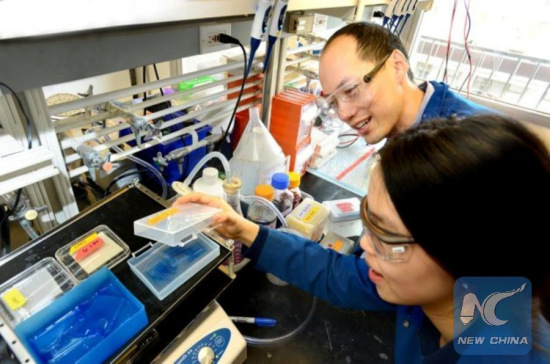
Chris Chang and UC Berkeley graduate student Sumin Lee carry out experiments to find proteins that bind to copper and potentially influence the storage and burning of fat. (courtesy of UC Berkeley)
A group of researchers has discovered that copper plays a critical role in metabolism by helping move fat out of fat cells and into the blood stream for use as energy.
Findings about copper and fat cells, called adipocytes, by the group from University of California, Berkeley, appeared online this week in a new study to be published in the July print issue of the journal Nature Chemical Biology.
"Unlike other studies that link copper levels both to increased or decreased fat metabolism, our study shows definitively how it works -- it's a signal that turns on fat cells," said Christopher Chang, a professor of chemistry and of molecular and cell biology at UC Berkeley.
"If we could find a way to burn fat more efficiently, this could be a big contribution to dealing with obesity and diabetes."
Without enough copper, fat builds up in fat cells without being utilized.
Previously, Chang showed that copper is a key signaling molecule in the brain, tamping down over-excitation of nerve cells.
The new study shows that copper plays a role throughout the body and the signaling is not restricted to a few elements on the periodic table, like sodium, calcium and potassium.
"Copper is a brand new class; in a sense we have basically added a fourth letter to the alphabet, in terms of metal elements that contribute to the language of signaling," said Chang, who also is a faculty scientist at Lawrence Berkeley National Laboratory and a Howard Hughes Medical Institute investigator.
Chang focused on fat metabolism after reading that copper is often given to cows to regulate weight gain. To discover how it works, he chose to study mice with a genetic defect that produces symptoms similar to those of a rare human illness, Wilson's disease.
In both situations, a key enzyme that moves copper in and out of cells is mutated, causing misregulation and copper overload in the liver. The condition is also characterized by bloated fat cells.
He and his team discovered that in the mice, copper is hoarded by the liver, basically starving fat cells of copper so that they cannot properly regulate fat storage and burning in organs such as the stomach and pancreas. This overload is accompanied by lower than normal levels of fats, or lipids, in the blood.
"Lipolysis is the breakdown of large pieces of fat into smaller pieces so they can circulate in the blood and be burned throughout the body," Chang said. "We discovered that in these Wilson's mice, low copper in the fat cells made them unable to burn fat as well as normal mice."
They tracked down exactly how copper works: It releases a brake on fat burning. Normally, a second messenger molecule called cyclic-AMP (cAMP) activates the enzymes that break down the fat molecules.
They found, however, that another enzyme called phosphodiesterase 3 (PDE3) blocks cAMP, probably to prevent fat breakdown. Copper blocks this enzyme, thereby "putting a brake on a brake," he said.
Chang is continuing his study of copper's roles in the brain and in fat metabolism, looking for possible ways to target the copper pathway to treat neurodegenerative brain diseases or diseases of metabolism, according to a release from UC Berkeley on Friday.
The similar roles copper plays in regulating nerve cells and fat burning highlight a growing perception that the neurological system, specifically the brain, plays a role in diseases of metabolism and the immune system, such as obesity and inflammation.
"Some of us are now thinking about obesity as a neurological disease rather than strictly a metabolic disease, because there are potentially connections between your fat tissue and the brain," he said.
"The notion that obesity and obesity-related diseases like diabetes may be neurological in nature opens the door to new basic science and therapeutic approaches."


















































